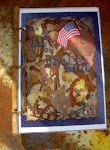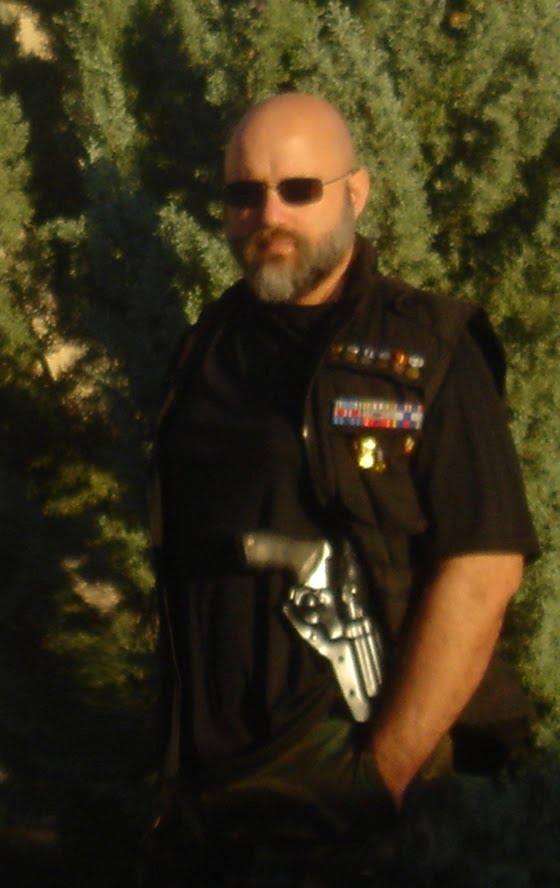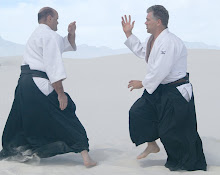
How do you quantify or qualify media bias?
People have been asking that question for a long time, and there really doesn’t seem to be a good answer.
I was trained at the Defense Information School. The media and journalism side of my primary duties in the military were tied very closely to Public Relations, and it wasn’t until I left the service, that I really understood what reporting the news was all about. The publisher who hired me ran a small-town daily, and he was old-school. There were many days I was called on the carpet for this or that and there were many meetings trying to explain the details behind one story or another – just trying to get them through to publishing.
There were no classes on media bias at DINFOS as I recall, and I don’t know if there are any today. But lately, I have been examining the question. As people line-up now to take whacks at ACORN – an organization seemingly rife with corruption, at least one TV show host, Glenn Beck, is asking the pertinent questions – the “why and the who and the “when.” We already know the “what.”
So while Beck is looking at the perpetrator question, I thought I’d investigate the “enabler” question. I wanted to know, with such a big story and so much obvious stink, why none of the alleged “mainstream” media is looking for the corpse. Why isn’t anyone else picking up the story?
So I’ve been investigating Annenberg. Please see my previous story for that one, because what I found was some obvious, direct connections to education – and in some instances, focused progressive education in the direction of media, broadcasting and journalism. The whole time I was looking down at this problem, trying to find a way to describe what I felt in my gut to be true.
Then I looked up.
In a dusty corner of my office, around a few other frames and plaques, there’s a “features” award from the AP. It was a proud day. I remember it clearly. There I was receiving a “first-place” for a feature, from the AP itself. To most people – hell, most reporters or broadcasters – they would say “so what?”
But to me that was a big deal. And I’m still proud of it. But now, it leads me to a realization that helps me write this story. Because, the article I wrote, which won that award was “The Art of Ranching.” It was a story about a young rancher who inherited a cattle ranch and through environmental means- in today’s parlance, “green initiatives” - he reintroduced the things, which ranchers had so long been eradicating; pests like groundhogs and insects and rabbits. The results: he reclaimed the failing property. Photographs of riparian areas taken in the early 1900s matched photos of the same areas in current day. The grasses were coming back – the ground was alive again. He was able to triple the size of his herd and still the land was improving.
It was a story about environmentalism in an environment, which hates that kind of thinking – traditional ranching. But the story won the AP award over so many others – why?
I would like to think it was because it was good writing, good research, good reporting, but maybe it was also about something else. Maybe it was about being a good “worker,” within the system, and writing the kinds of things the judges like to read.
Because, you see, to get an article out on the national wire when I was a reporter meant that you had to submit it to the wire services and they had to decide to pick it up. If they didn’t like it, then that piece would never see the light of day. You might reach a few people locally, in your own paper’s circulation, but regardless of how earth-shaking the story, you would get zip – zot – nothing and nowhere.
So I looked at my award with new eyes and suddenly saw all my recent research fall into place, like gears in a giant machine. It’s the kind of machine that grinds slowly with heavy, cumbersome, greasy parts. It groans and gnashes with dark intention and it fills rooms – many rooms, all across the nation. It grinds slow because it has been built slowly and carefully over time, silently slipping into schools across the entire spectrum, building an environment of politically correct thinking – progressive thinking. The opposition has been either removed or has gone out by attrition and has been replaced by others; those who will maintain and feed the machine.
They are feeding the machine our young.
To begin with, it is nearly impossible to unravel half a century of school “reform.” The changes it encompasses often are subtle and if not seemingly benign in nature, are cloaked in packaging and nomenclature which suggest the gentle, kindly people tinkering with the system, only have the best interests of the children at heart.
And sometimes they really do. Besides, only madmen go into a thing with intention to do harm. No, in this case, the machine is built slowly, one cumbersome piece at a time. It may start with a really great idea, like Annenberg, a major initiative to revive and inspire K-12 public education across the United States. But the foundation of Annenberg was already much larger, and with the funding of the K-12 programs soon expanded.
The Annenberg Public Policy Center of the University of Pennsylvania was established in 1994. Through offices in Philadelphia and Washington, D.C., according to the Annenberg website, “it conducts and disseminates research, hosts lectures and conferences, and convenes discussions on the critical intersection of media, communication, and public policy. Research focuses on questions and issues in political communication, information and society, media and the developing child, health communication, and adolescent risk.”
This policy center has developed such gems as FactCheck.org, which “aims to increase public knowledge and understanding by monitoring factual accuracy of political dialogue. The center is also responsible for the National Annenberg Election Survey, the nation’s largest academic election poll.
Just two questions there... what do K-12 students need with “understanding factual accuracy of political dialogue? And how many K-12th grade students are remotely involved in election polls? The answer of course, is none. The Annenberg foundation is stretched out into many different areas including higher education and beyond.
Annenberg is plugged into the political process, because in 1958, the Annenberg School for Communication at the University of Pennsylvania got up and running. The School’s purpose; to examine “various approaches to the study of communication and its methods drawn from both the humanities and the social sciences. It calls itself “an intellectual common market” and contains social scientists, historians and critics. Masters and Doctoral programs “prepare students to make professional contributions to communication scholarship, research and policy.”
In 1971, the Annenberg School for Communication at the University of Southern California began as a small graduate institution and was reorganized in 1994 to include the USC School of Journalism and the Department of Communication Arts. It claims to prepare “students to study, understand and manage important communication in education, politics, management, marketing, government and non-governmental institutions.”
One of USC’s programs is the Center for the Study of Journalism and Democracy.
In July 2009, David Whestphal a senior fellow with the Center on Communication Leadership and Policy and executive in residence, Annenberg School for Communication, USC, wrote “This model, in which special-interest foundations establish news organizations that report on funders’ interest areas, traditionally has raised several concerns. For health-news consumers, there’s the question of whether the coverage is somehow shaped by the interests of the funder...”
Westphal’s article, references Alex Jones, who has led what Westphal called “one of the nations most prominent nonprofits, the Joan Shorenstein Center on the Press, Politics and Public Policy, for the past nine years.”
Westphal wrote:
"Jones wants one or more of the world’s richest people to establish a $2 billion endowment that would provide permanent funding for PBS’ “NewsHour.” “If Warren Buffett or a group of billionaires wanted to change the world, this is how they could do it,” he said. “It’d be one hour of prime viewing time for every television in the country. It would give the United States the genuinely high-quality TV news operation that it has never had.”
But this is all looking at the journalistic field from the bottom up. What does it look like from the top down? To examine this, it is easiest to go straight to the top. In the wake of a fantastic investigative piece of work done by two young people on the ACORN organization, it should be asked, will these two people be considered for the prestigious Pulitzer Prize.
It seems doubtful. This is because looking from the top, down into the Pulitzer committee – at what should arguably represent the best-of-the-best in the journalism field, some unusual trends come to light.
For example, look at David Kennedy. Kennedy served as a Pulitzer Prize juror in the history category in 1984, 1994 and 2002 and was elected to the Pulitzer Prize Board in 2002.
Kennedy, named a fellow of the American Council of Learned Societies and the Guggenheim Foundation, was selected to the American Academy of Arts and Sciences and the American Philosophical Society. He has written in The Historian, Reviews in American History, Encyclopedia of American Biography, the Dictionary of American Biography, The Nation, The New Republic, The London Review of Books, The Atlantic Monthly, The Los Angeles Times and The New York Times.
Many might wonder what a top journalist and Pulitzer jurist like this would write about? Surely, such a worldly beacon of journalism would produce exceptional prose. Here’s a small selection from an article written by Kennedy:
The Best Army We Can Buy
By DAVID M. KENNEDY
Published: July 25, 2005
THE United States now has a mercenary army. To be sure, our soldiers are hired from within the citizenry, unlike the hated Hessians whom George III recruited to fight against the American Revolutionaries. But like those Hessians, today's volunteers sign up for some mighty dangerous work largely for wages and benefits - a compensation package that may not always be commensurate with the dangers in store, as current recruiting problems testify.
<...>
Some will find it offensive to call today's armed forces a "mercenary army," but our troops are emphatically not the kind of citizen-soldiers that we fielded two generations ago - drawn from all ranks of society without respect to background or privilege or education, and mobilized on such a scale that civilian society's deep and durable consent to the resort to arms was absolutely necessary.
Leaving questions of equity aside, it cannot be wise for a democracy to let such an important function grow so far removed from popular participation and accountability. It makes some supremely important things too easy - like dealing out death and destruction to others, and seeking military solutions on the assumption they will be swifter and more cheaply bought than what could be accomplished by the more vexatious business of diplomacy....
This historian and professor, a Pulitzer winner himself, has taught at Stanford University since 1967. His book, Over Here: The First World War and American Society, and Freedom From Fear, won the Pulitzer Prize in history in 2000.
He earned his B.A. in history in 1963 from Stanford University, then continued his studies at Yale, where he was awarded a master's degree and doctorate in American Studies.
And although many might think the viewpoint expressed in this single article, not representative of the man’s work, there’s more – a lot more. How about writing that Abraham Lincoln was considered so divisive a figure that his election “triggered a civil war.”
But that’s enough about Kennedy. What about Jay T. Harris, former publisher of the San Jose Mercury News and director of The Center for the Study of Journalism and Democracy at the Annenberg School of Communication, USC.
Harris eventually served as assistant dean, of Northwestern's Medill School of Journalism. He is credited with creating the American Society of Newspaper Editors' annual national census of minority employment in daily newspapers. But Harris is also a Senior Fellow on the Salzburg Board of Directors for Salzburg Global Seminar, headquartered in Austria, is a massive independent Non-Governmental Organization with a board of directors, which according to their website is “drawn from diverse regions, backgrounds and fields of expertise.”
According to the website: “It seeks in its’ faculties, fellows and staff people of the highest intellectual and leadership capacity from around the world and from all sectors of society and attempts to benefit from their breadth of experience and perspective across the full range of their work.”
The Salzburg Global Seminar also “seeks to challenge present and future leaders to solve issues of global concern.” Their strategy “is to convene imaginative thinkers from different cultures and institutions, organize problem-focused initiatives, support leadership development and engage opinion makers through active communication networks, all in partnership with leading institutions from around the world and across different sectors of society.”
The values of this far-reaching organization move far outside the world of journalism. They “seek to magnify the impact of individuals and institutions that bring just and humane values to bear on global challenges facing their societies and the world.”
But Harris is involved in an organization, which reaches even further – into the re-writing of history and “historical reparations.”
The Institute for Historical Justice and Reconciliation is involved with educational and public policy institutions to “organize and sponsor historical discourse in pursuit of acknowledgement, and the resolution of historical disputes. In October 2008, the IHJR was established as an independent institute in The Netherlands and is now a nonprofit foundation seated in The Hague.”
Beneath the IHJR title is this: The IHJR seeks to dispel public myths about historic legacies in societies divided by ethnic conflict.
So how does any of this relate to journalism? Because if organizations are teaching or encouraging viewpoints from these kind of global groups to fresh minds entering the journalism field, how is it possible for these people to end up as objective minds when they enter the market? Isn’t it more likely that many of those taught and influenced by people involved in organizations like this, will develop similar perspectives – perspectives which they are also instructed to view as centrist and objective?
So what about the dusty award for a feature story on the wall of that office? Signed by an editor at the Associated Press, that award is basically given where the rubber meets the road in journalism. It’s certainly not in the lofty heights where Harris and Kennedy live and work, but rather, down where some $7.50-an-hour reporter spends 15-20 hours of on unpaid overtime each week, covering their assigned beats for a small daily or a tiny radio station somewhere in the back of beyond.
These reporters come from less-refined backgrounds – like myself. But they may attend some of the civilian journalism schools out there at places like USC or maybe on the other side of the country at City University of New York’s Graduate School of Journalism.
According to the CUNY website, “There can be no more dynamic environment in which to learn and work than New York City. The city is the media capital of the world, and the Graduate School of Journalism is situated in its very heart.”
Three people on the Journalism school’s faculty are Pulitzer Prize winners.
And CUNY has a fairly up-front ethics policy, which reads in part, “The duty of journalists is to inform the public in ways that promote understanding of past or current events and the workings of a democratic society. To be credible and trustworthy, we seek truth in an unbiased way, always striving for a fair and comprehensive account of events and issues.”
CUNY Graduate School of Journalism is part of the CUNY Graduate Center, which apparently as a whole, embraces a wide variety of policies and perspectives. Frances Fox Piven is a Professor of Political Science and Sociology at CUNY. Piven co-authored a book with Richard Cloward, titled Regulating the Poor. The book, details the role of welfare policy in the economic and political control of the poor and working class. She also wrote Poor Peoples' Movements (1977), which looks at insurgent social movements and how they produce policy reforms. Another Piven book, Why Americans Don't Vote (1988) was updated to Why Americans Still Don't Vote in 2000), digs into the role of electoral laws and practices in disenfranchising the working class and poor. Lastly, Piven wrote The War at Home (2004), which examines the domestic causes and consequences of the foreign wars launched by the Bush administration.
And best of all, her book, Challenging Authority: How Ordinary People Change America, shows the interplay of disruptive social movements and electoral politics in generating the political force for “egalitarian reform in American history.”
Piven is on a board for the leftforum.org., along with a couple other CUNY people including Stanley Aronowitz, a Professor of Sociology at CUNY Graduate Center, where he is Director of The Center for the Study of Culture, Technology and Work.
The leftforum.org, convenes the largest gathering in North America of the US and international Left every spring. Continuing a tradition begun in the 1960s, the organization assembles intellectuals and organizers to share perspectives, strategies, experience and vision.
According to their website, the most recent forum, held at Pace University in New York City, included approximately 3,000 participants, over 200 panels, and 650 speakers from over 40 countries.
“For the US and the world, revitalizing an American Left has never been more urgent,” explains a description of the organization on their website. “Left Forum has a critical role to play in that undertaking. Our work parallels and cross-fertilizes with the renewal of left strength elsewhere—from indigenous movements in Bolivia to the South Korean farmers to the electoral gains of European and Latin American left parties. Like many movements abroad, Left Forum seeks to link the critique of neo-liberalism to anti-capitalism, and to foster radical alternatives to the established order.”
Piven and Aronowitz are on that board with Jamie McCallum, Hobart Spaulding, William Tabb and Julia Wrigley, all of them also from CUNY.
MacCallum studies Sociology at the CUNY Graduate Center, and teaches in the Urban Studies department and the Center for Worker Education at Queens College. He is described on the leftforum website as “an agitator for social justice.”
He was a labor organizer in New York and California, and helped build worker-activist alliances before the WTO protest in Seattle in 1999.
Spalding is retired as Professor of History from the City University of New York (CUNY). His work has focused on Latin America and the Caribbean, specifically the working class and labor history. He sits on the editorial board of several publications, most notably Socialism and Democracy.
Tabb taught economics at Queens College and economics, political science and sociology at the CUNY Graduate Center. He has written books including the Economic Governance in the Age of Globalization (Columbia University Press, 2004) and The Amoral Elephant: Globalization and the Struggle for Social Justice in the Twenty-First Century (Monthly Review Press, 2001). Lastly, Wrigley is a Professor of Sociology at the CUNY Graduate Center and the author of Class Politics and Public Schools and Other People's Children.
These CUNY educators are on the same board with Richard D. Wolff, a Professor of Economics at the University of Massachusettes. Wolff’s publications, current research, and teaching concentrate on developing and applying Marxian economic theory. According to the leftforum website, his most recent books, co-authored with Stephen Resnick, are New Departures in Marxian Theory (Routledge Publishers: London and New York, 2006) and Class Theory and History: Capitalism and Communism in the USSR (Routledge Publishers: London and New York, 2002). He also serves on the editorial board of Rethinking Marxism.”
These are just a sampling of university educators and their belief systems. These belief systems are at least in part, transferred to students and carried forward. In the field of journalism – as in many other occupations - developing perspectives, influenced by folks like this, are subsequently reinforced by recognition, awards, status and pay. The truth of this assertion can be found in a letter to Andy Stern, President of SEIU dated May 1, 2008. Two of the individuals who signed that letter were Aronowitz and Piven. The rest of those who signed it are listed below with the full contents of that letter, which can be found at calnurses.org:
An Open Letter of Concern To Andy Stern
About United Healthcare Workers-West
Mr. Andy Stern, President
May 1, 2008
Service Employees International Union
1800 Massachusetts Avenue, NW
Washington, DC 20036
Dear Andy:
We are writing to you as journalists, authors, political activists, and educators who are committed to organized labor because of its important role in social justice struggles in the U.S. Some of us have longstanding ties to SEIU and have done research, writing, or labor education work involving its members, organizers, and local leaders. Those of us who deal with graduate students or undergraduates have encouraged younger people to pursue internships or full-time job opportunities with SEIU and other Change To Win or AFL-CIO unions. A number of us belong to unions ourselves. Many of us have been part of community-labor coalitions or campus-based groups like Scholars, Artists, and Writers for Social Justice (when it was still active) because we support organizing and bargaining by janitors, cafeteria workers, and other service sector employees.
We are writing to express our deep concern about SEIU's threatened trusteeship over its third largest local, United Healthcare Workers (UHW). We believe that there must always be room within organized labor for legitimate and principled dissent, if our movement is to survive and grow.
Putting UHW under trusteeship would send a very troubling message and be viewed, by many, as a sign that internal democracy is not valued or tolerated within SEIU. In our view, this would have negative consequences for the workers directly affected, the SEIU itself, and the labor movement as a whole. We strongly urge you to avoid such a tragedy.
Sincerely,
Michael Albert, Author, co-founder South End Press and Z Magazine*
Richard P. Appelbaum, Professor of Sociology, University of California-Santa Barbara
Stanley Aronowitz, Professor of Sociology, CUNY Graduate Center
Sara Abraham, Sociology, University of Toronto
Frank Bardacke, Author and Educator
Jennifer Berkshire, Journalist and Editor
Elaine Bernard, Labor and Worklife Program, Harvard Law School
Fred Block, Sociology Department, University of California-Davis
Edna Bonacich, UC-Riverside
Eileen Boris, Women's Studies Professor, University of California, Santa Barbara
Joanna Brenner, Portland State University
Robert Brenner, Professor of History, UCLA
Kate Bronfenbrenner, Cornell ILR School
Dan Brook, Sociology, San Jose State University
Michael Jacoby Brown, Founder, Jewish Organizing Initiative
Anita Chan, Australian National University
Noam Chomsky, Professor of Linguistics (Emeritus), MIT
Levon Chorbajian, Sociology, U-Mass, Lowell
Dan Clawson, Sociology Professor, U-Mass Amherst
Bruce Cohen, Associate History Professor, Worcester State College
Tim Costello, Labor Researcher and Author
Mike Davis, Author and Professor, UC-Irvine
Ellen David-Friedman, Founder, Vermont Workers Center and former VEA Staff Member
Michael Denning, Professor of American Studies and Director, Initiative on Labor and Culture, Yale
G.William Domhoff, Sociology Professor, UC Santa Cruz
Jill Esbenshade, San Diego State University
Tess Ewing, U-Mass Boston Labor Center
Rick Fantasia, Sociology Dept., Smith College
Leon Fink, Professor of History, University of Illinois at Chicago
Richard Flacks, UC Santa Barbara
Bill Fletcher, Jr. Co-founder, Center for Labor Renewal & Exec. Editor, Blackcommentator.com
John Bellamy Foster, Professor of Sociology, University of Oregon
Harris Freeman, U-Mass Amherst Labor Center
Yoshie Furuhashi, MRZine
Bill Gallegos, Communities for a Better Environment
William A. Gamson, Professor of Sociology, Boston College and former American Sociological Association president
Zelda Gamson, Senior Associate, New England Resource Center for Higher Education
Dan Georgianna, University of Massachusetts Dartmouth
Sam Gindin, Packer Chair in Social Justice at York University, former CAW Research Director
George Gonos, Sociology, SUNY Potsdam
Suzanne Gordon, Journalist & Author
Jim Green, Professor of History and Labor Studies, U-Mass Boston
Brian Greenberg, Department of History and Anthropology, Monmouth University
Michael Honey, University of Washington
Thandabantu Iverson, Assistant Professor in Labor Studies, Indiana University
Robin D.G.Kelley, Professor of History, USC
Howard Kimeldorf, University of Michigan
Jennifer Klein, Department of History, Yale
Kitty Krupat, City University of New York
Nelson Lichtenstein, Professor of History, UC Santa Barbara
Stephanie Luce, Associate Professor, Labor Center, U-Mass-Amherst
Biju Mathew, Assistant Professor of Business, Rider University
Dale Melcher, U-Mass Labor Extension
Tom Mertes, UCLA Center for Social Theory
Jack Metzger, Emeritus Professor of Humanities, Roosevelt University
Nancy McLean, Professor of History, Northwestern University
James Monsonis, Professor Emeritus, Simon's Rock College
David Montgomery, Professor Emeritus, Yale
Carolina Bank Munoz, Assistant Professor of Sociology, Brooklyn College-CUNY
Ruth Needleman, Professor of Labor Studies, Indiana University
Manny Ness, Brooklyn College, CUNY
Frances Fox Piven, CUNY Graduate Center
Vijay Prashad, Trinity College
Peter Rachleff, History Dept., Macalester College
Marcus Rediker, History, Univ. of Pittsburgh
Adolph Reed, Professor of Political Science, Univ. of Pennsylvania
Thomas Reifer, Assistant Professor, Sociology and Ethnic Studies, University of San Diego
Christopher Rhomberg, Yale University
Corey Robin, Associate Professor, Political Science, Brooklyn College
Ian Robinson, University of Michigan
Carlos Rosado, Chicago-Kent College of Law
Lucy Rosenblatt, Psychotherapist, Health Workers for People Over Profits
Andrew Ross, New York University
Robert J. S. Ross, Sociology Professor, Clark University
Daisy Rooks, Rutgers University
Jay Schaffner, Author and Moderator, Portside
Michael Schwartz, SUNY Stony Brook
Robert Schwartz, Author and Attorney
Kim Scipes, Professor of Sociology, Purdue
Dennis Serrette, President, United Association for Labor Education
Rae Sovereign, Labor Studies Program, Indiana University-South Bend
Chris Spannos, ZNet and Z Communications
Judith Stepan-Norris, UC-Irvine
Alan Wald, Professor, University of Michigan
Richard Walker, Geography Dept., UC-Berkeley
Immanual Wallerstein, Professor of Sociology, Yale University
Victor Wallis, Berklee College of Music
Andrea S. Walsh, Lecturer, MIT
Dorian Warren, Columbia University
Eve Weinbaum, U-Mass Amherst
David Wellman, Sociology Dept., UC-Santa Cruz
Suzi Weissman, St.Mary’s College of CA
Cal Winslow, Fellow, Environmental Politics, UC Berkeley
Steffie Woolhandler & David Himmelstein, Harvard School of Public Health and PNHP
John Womack,History Professor, Harvard
Michael D. Yates, Professor Emeritus, University of Pittsburgh
Dr. Quentin Young, PNHP
Maurice Zeitlin, Dept. of Sociology, UCLA
Howard Zinn, Author, Playwright, and Professor Emeritus, Boston University
Michael Zweig, SUNY at Stony Brook
So if these are the educators working directly with students, and they have “done research, writing, or labor education work involving its members, organizers, and local leaders,” and “have encouraged younger people to pursue internships or full-time job opportunities with SEIU and other Change To Win or AFL-CIO unions.” Then who are on the other end of the spectrum giving the encouragement and the awards?
For this we can look back at recent times within the AP. This is the same organization, which distributed a photo of mortally wounded Marine Lance Cpl. Joshua M. Bernard, 21, of New Portland, Maine, even after being asked by the young man’s father not to do it.
Bernard was struck by a rocket-propelled grenade in a Taliban ambush Aug. 14 in Helmand province of southern Afghanistan, and although the AP waited until after the burial, they still distributed them, saying the photo was “...part of the history of this war.”
Bernard's father after seeing the image of his mortally wounded son said he was against publication, calling it disrespectful to his son's memory.
That’s the AP – as an organization. But what do they look like up close? How about looking at the Pulitzer Prize winners? Associated Press reporters and photographers have won 49 Pulitzer Prizes, more than any other news organization in categories for which it can compete. The AP has won 19 Pulitzer Prizes for writing and 30 Pulitzer Prizes for pictures.
Here’s some highlights from the AP itself:
2005 -Bilal Hussein, Karim Kadim, BrennanLinsley, Jim MacMillan, Samir Mizban, Khalid Mohammed, John B. Moore , Muhammad Muheisen, Anja Niedringhaus, Murad Sezer and Mohammed Uraibi for breaking news photography for a stunning series of pictures of bloody yearlong combat inside Iraqi cities.
2000 -Sang-Hun Choe, Charles J. Hanley, Martha Mendoza and Randy Herschaft for Investigative Reporting, for "The Bridge at No Gun Ri," a package of stories reporting the mass killings of South Korean civilians by American troops at the start of the Korean War..
1995 -Mark Fritz, for reports on the ethnic violence in Rwanda.
1995 -Jackie Arzt, Javier Bauluz, Jean-Marc Bouju, Karsten Thielker for photos of the ethnic violence in Rwanda.
1991 -Greg Marinovich, for a series of pictures showing the brutal killing of a man believed to be a Zulu Inkatha supporter in South Africa.
1983 -Bill Foley, for a series of pictures of victims and survivors of the massacre of Palestinians in a refugee camp in Beirut.
1982 -Saul Pett, for a series of stories on the bureaucracy of the federal government.
1978 -J. Ross Baughman, for a series of pictures showing white Rhodesian soldiers beating and torturing black nationalist guerrillas.
1977 -Neal Ulevich, for a series of pictures showing bloody fighting between police and left-wing students in Bangkok, Thailand.
1973 -Huynh Cong (Nick) Ut, for a picture of a Vietnamese girl fleeing in terror after a napalm attack.
1972 -Horst Faas and Michel Laurent, for a series of pictures of tortures and executions in Bangladesh.
1970 -Steve Starr, for a picture of armed black students emerging after their 36-hour occupation of a Cornell University building.
1969 -Edward (Eddie) Adams, for a picture of Vietnamese Brig. Gen. Nguyen Ngoc Loan executing a Viet Cong prisoner on a Saigon street.
1958 -Relman Morin, for reports on school desegregation rioting at Little Rock.
1951 -Max Desfor, for a picture of Korean War refugees in flight over ruins of a Taedong River bridge.
1951 -Relman Morin and Don Whitehead, for war reports from Korea.
1947 -Arnold Hardy, for his photo of a girl leaping to death in a hotel fire.
Notice any kind of similarity in content? Do you wonder why so much horror and grief and despair is winning the top awards in journalism? Is it just because “bad news sells papers? Or can we draw any conclusions from this – can we say that a certain type of reporting is being rewarded?
If you look at these events, you have race-war, death, destruction, “evil” U.S. government and evil U.S. troops, sad third-world violence, and to use the AP’s words “a stunning series of pictures of bloody yearlong combat inside Iraqi cities.”
Wow. It just makes a person want to see more, doesn’t it? Yet year after year, despite thousands, maybe millions of stories and photos, and billions of dollars being spent, this is the kind of stuff selected for the top award – the Pulitzer.
To be fair, however, AP has made a difference, influenced people, exposed truths – and there were other, brighter topics, which won the day. But the greatest majority of material selected seems geared to these themes. Just consider for a moment, how the average person would feel capturing a photo of a girl leaping to her death in a hotel fire? And how must you feel accepting an award for that kind of material? I think I would rather destroy it. I think I would never allow those pictures of the dying Marine to leave the scene. I would have punched up “delete” on my digital camera, or popped the back of my analog rig and torn the film out, exposing it – allowing the light of day to fade away the darkness, forever.
But these individuals chose not to do those things. Is that professionalism over-riding the impulse to do the right thing? And is it possible to know what that says about us all. Not really. Is it enough to say that they were doing their job, while people bled out? Is it enough to say they were serving humanity when they couldn’t even serve the wishes or needs of a grieving father who’s son died bravely and honorably - so that those very same AP executives could continue to eat in fancy restaurants, live comfortable, happy lives and talk about their daily works?
How are journalists produced? Can we really say it is not a type of indoctrination? Where is objectivity when even simple humanity is ignored to boost circulation? How can you claim neutrality when you benefit from bringing in a particular kind of story – when you’re paid for a specific perspective?
What is truth but perception and what is perception, but perspective. I may respond to anger, with anger and to harsh words with the same. I may choose to accept my view of the world justifies some kind of opposite reaction. But I would be wrong.
They say that with certain conditions you simply can’t see them, because you are on the inside looking out. So, when you try to see the problem, it evades detection, because it is itself, a part of you. Some soldiers and civilians who have lived through terrible, traumatic circumstances, suffer from a condition like this – it’s called Post Traumatic Stress Disorder. So what condition does the alleged “mainstream media” suffer from?
I do not believe these agencies are corrupt or in total, biased. But, there are groups involved in training our young people and they have been at work within our education system, for a long time, influencing the development and education of the new people swelling their ranks. That stewardship has maintained a horrific machine, which is called “indoctrination” and has been folding generations of people into an alternative perspective; a different way of seeing things.
When people ask why the mainstream media isn’t covering certain breaking stories, what is more likely – a conspiracy of epic proportions, or simply a group of people who have a special kind of organizational blindness coupled with economic and professional encouragement?
They believe their world-view to be correct and they can’t imagine a different way or a different world. Their viewpoint is reinforced daily by peers and bosses in their hierarchy. I suppose that says something important. Maybe we are lacking imagination or vision – of course, maybe believing that I know that, is equal intellectual hubris or a lack of imagination itself.
But I heard something recently, which is certainly true. Maybe this is the only truth: If we wake up alive again tomorrow – any of us, or all of us – we will have a new day to try to be a better person.
It would be great, if we could all develop that as a perspective.
Wouldn’t it?


















No comments:
Post a Comment